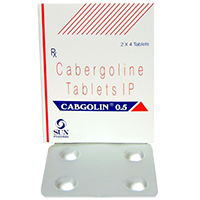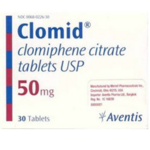
Cabgoline

What is Cabgoline?
Cabgoline is one of the drugs used when suffering from hyperprolactinaemia, which is when the levels of prolactin in the blood are too high. This hormone produced by the pituitary gland (one of our endocrine glands), in fact, under normal conditions is very low in both men and women, its level rises only during pregnancy and lactation, given that its primary function is to stimulate the production of breast milk.
Cabgoline is also used in other conditions associated with high prolactin levels. Its use is popular in the world of sports and men’s sexual health, as it is a powerful dopamine agonist that stimulates production of testosterone. Cabergoline promotes weight loss as a secondary beneficial effect in individuals with overweight and obesity caused by elevated prolactin titers.
Mechanism of action

Cabergoline is a dopaminergic derivative of ergots, characterized by strong and prolactin-depressant activity. The drug directly stimulates the D2-dopamine receptors on the surface of the lacto-purple pituitary cells, thereby inhibiting prolactin secretion. This substance reduces prolactin secretion in rats at oral doses of 3-25 μg / kg and in vitro at a concentration of 45 pg / ml.
In addition, cabergoline has a central dopaminergic effect by stimulating D2 receptors in oral doses higher than those that are effective in lowering levels of prolactin in serum. The long-term effect of Cabgoline on prolactin levels is probably due to its long-term persistence in the target organ, as evidenced by the slow rate of elimination of total pituitary radioactivity after a single oral dose in rats (the drug’s half-life is approximately 60 hours).
What Is Cabergoline used for?
What kind of drug is it and what are its indications and possible side effects? The active ingredient in Cabgoline is a substance called cabergoline. In what cases does the doctor prescribe this drug?
- Inhibition or suppression of lactase (the production of breast milk) after giving birth (if the mother does not want to breastfeed), or after an abortion;
- Treatment of hyperprolactinemic disorders in both men and women
In the first case, when Cabgoline is used to interrupt the normal production of breast milk, these are the doses indicated and the way of use:
To inhibit (but not completely interrupt) lactation, a dose of 1 mg per day is recommended (equal to two tablets in a single solution, to be taken after a meal) starting from the first day after delivery
To completely stop lactation, instead, the dose of Cabgoline remains the same but the administration changes. We recommend taking half a tablet (equal to 0.25 mg) every 12 hours for two days
In the case of hyperprolactinemia, a predominantly female disorder that is associated with symptoms such as amenorrhea (interruption of the menstrual cycle), breast swelling with milk production and infertility, Cabgoline posology is as follows:
Generally the therapy is started with a gradual weekly administration, ie a 0.5 mg tablet to be divided into twice a week (e.g. half a tablet on Monday and the other half on Thursday). Subsequently, the dose is increased up to the one that makes up the optimal proportion which is 1 mg (two tablets) per week.
Cabgoline and sex drive
Cabgoline has a powerful dopaminergic action, which means it is a dopamine agonist (a substance with close affinity to dopamine, a substance found in the brain that plays an important role in the reward system of the brain).
For sexual desire to occur, the brain must produce in quantity a neurotransmitter, dopamine, which stimulates desire and the production of the inhibiting substance must be slowed down: serotonin. It is therefore necessary to get out of emotional anesthesia, so that there is also a reduction in the production of endorphins by the hypothalamus. Cabgoline, by imitating the action of dopamine, boosts sexual drive and makes sexual activity more pleasurable.
On the flip side, in some individuals Cabgoline can cause exaggerated sexual behavior and hypersexuality, as well as increase gambling and other kinds of addictions. The drug therefore should not be administered in individuals with known history of addictive behavior and psychosis.
Cabgoline in bodybuilding
Cabgoline is used in athletes to increase the amount of testosterone production and to counter the side effects of steroid anabolics. Those letter have gynecomastia and ED as their serious side effects.
The term “gynecomasita” refers to the development of mammary glands in males. It is a common side effect among men who use androgenic steroids. It arises when a steroid aromatizes (excess testosterone or androgens are converted to estrogen in the body’s attempt to maintain balance). In this case the estrogen levels become very high, mimicking the patterns of the female hormone that initiate the formation of the chest. The latter is caused by elevated levels of prolactin, another hormone that is elevated in men by the pituitary gland.
Changes in libido occur suddenly when entering / exiting steroid cycles. Many times men find a higher sexual interest at the beginning of the steroid cycle, accompanied by increasingly frequent and long erections. As the steroid cycle continues, this reaction has a reversal, leaving the unlucky person with little ability to maintain an erection for as long as desired. The physiological factors that contribute to ED include a decreased production of the physiological testosterone produced by the testicles (the exogenous steroid short-circuits the physiological endogenous feedback system).
In both instances, Cabgoline is a first-line defense to both foster normal secretion of testosterone by the body and decrease the levels of prolactin.
The action the drug induces

Inhibition of prolactin secretion via ergot alkaloids has revolutionized the treatment of pseudo-pregnancy. Prolactin secretion in mammals is controlled by complex stimulation and inhibition systems. Prolactin secretion from the pituitary gland is mostly under the inhibitory control of the hypothalamus, through the direct action of dopamine, the major inhibitor of prolactin. This inhibition can be indirectly modulated by serotonin, which suppresses the release of doppamine and increases prolactin. In addition, hypothalamic THR causes prolactin release in addition to TSH release.
The most common derivative used clinically to inhibit prolactin secretion is cabergoline, the active substance in Cabgoline, which has a direct action on dopamine receptors. Cabergoline has greater bioactivity than other drugs used for the same purpose, higher specificity for D2 receptors and a longer duration of action than bromocriptine. Its potency is greater than certain antiprolactin dopamine agonists used in human medicine (terguride and lysuride). It can be given once a day. Cabergoline crosses the blood-brain barrier only slightly and consequently has fewer effects on the center of vomiting than the other dopamine agonists. ED50 for vomiting is 4 times the therapeutic dose. Cabergoline is administered in dosages of 5 micrograms / kg / day every 5-10 days. In line with the prolonged duration of action, cabergoline shows a certain effectiveness 2 or more days after the end of administration.
Dosing regimen for athletes
Cabgoline is taken at the doses of 0.25 mg twice a week in order to minimize the side effects of anabolic steroids. If the efficacy of the drug is found insufficient at this dosage, it can be increased to 0.5 mg twice a week, subject to prescriber’s decision. Dose titration should be done with no greater frequency than once every 4 weeks.
Who should better avoid Cabgoline?
Higher doses or a higher cumulative total dose of cabergoline were found to be risk factors for the development of valvular heart disease. Cabergoline-containing products already have a contraindication to indicate changes to heart valves and a second-line treatment option. The most significant change for use in Parkinson’s disease is the reduction of the maximum daily dose of cabergoline.
In addition, the following changes should be made to all applications:
- All patients must undergo cardiovascular testing, including echocardiogram, before starting long-term treatment.
- Heart valve changes, detected by echocardiography before treatment, are a contraindication to the use of cabergoline or pergolide.
- Clinical diagnostic monitoring for the development of valvular heart disease or fibrosis is essential, not only recommended.
- a limitation of indication of cabergoline as a second-line agent should be made when used alone or as adjunctive therapy to levodopa plus decarboxylase inhibitors when treatment with a non-ergotamine dopamine agonist is ineffective or intolerable;
- the contraindication for patients with a history of pulmonary, pericardial and retroperitoneal fibrotic disorders and / or evidence of anatomical change in a heart valve;
- There is a risk of fibrotic and serous inflammatory diseases such as pleurisy, pleural effusion, retroperitoneal fibrosis, fibrotic heart valve changes after prolonged use of cabergoline;
- A cardiovascular check-up should be made before the start of treatment;
- Indication of the necessity of discontinuation of treatment in the presence of manifest ECG changes as an expression of the above changes in the valve apparatus;
- There are warnings on hypersexuality, libido enhancement and pathological gambling after dopamine agonists including cabergoline.
Side effects
Attention to the following symptoms should be paid during treatment:
- Dyspnea
- Shortness of breath
- Persistent cough and chest pain and pain in the lumbar region as a possible sign of progressive retroperitoneal fibrosis which may also result in constriction of the ureters and blood vessels in the abdomen.
- Heart valve changes and associated diseases are listed as very common side effects.
- Cabgoline can cause renal insufficiency.
- In the specific literature, warnings are made of possibly developing heart failure as a sign and consequence of valve fibrosis.
- Increased libido and hypersexuality,
- Pathological gambling (gambling addiction)
Cabgoline and alcohol
At present, the effects of alcohol on the general tolerance of Cabgoline are not known.
Cabgoline analogs

- Cabgoline
- Cabergoline
- Cabgon
- Cablize
- Caberlin
- CB-LIN
- Colette
Posted in Women’s Health
(1 voices, average: 5 of 5) 6666 views





















